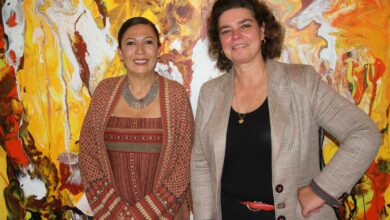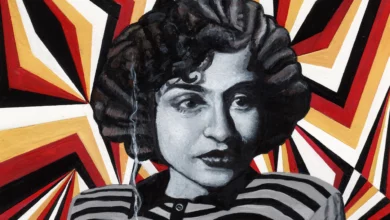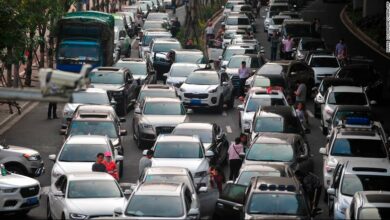On 6 October, a small crowd of inventors, artists, designers and engineers gathered at the American University in Cairo to attend Maker Faire Africa 2011. The third edition of a three-day annual event devoted to the encouragement of innovation and creativity across the African continent, this year saw a roster of local and foreign participants, presenting ideas that ranged from the inspired to the completely impractical.
Stationed outside the official entrance with his team members, Ahmed al-Wakil points to a strangely modified parked car when asked about his contribution to Maker Faire. “This,” the recent Cairo University graduate beams, “is just like the cars you see in the James Bond movies.” While it’s safe to say 007 wouldn’t be caught dead in a Kia, Wakil’s point is made clear when, using the cursor keys on his laptop, he brings the previously parked car to life.
“An invention like this has endless applications,” says Wakil. “Disabled people can sit in the passenger seat and use their laptops to drive, and military and emergency services can use it to reach destinations that might be too dangerous for human drivers.” Wakil uses an internet connection to deliver his commands to the car. A mechanical apparatus fixed around the steering wheel immediately responds to his keyboard controls, and a series of cameras positioned around the car’s exterior provide a real-time visual link to the laptop. Besides the cameras, the car’s body is also fitted with sensors due to the fact that “internet connections can be very unreliable, so you need a fail-safe system to prevent collisions.” Should the connection fail, the car is also equipped with an emergency brake system that will bring it to a quick, yet measured, stop.
“Instead of having to leave your house, you can just send the car to pick up your kids from school,” says Wakil, adding that the program can be easily adapted to all models and types of automobiles. “It’s just like playing Need for Speed.”
Parents who remain unsure about risking their children’s lives in a driverless, video-game inspired car might feel more comfortable at Ahmed and Mahmoud Saad’s booth, where the two brothers have made a collection of pencils using recycled material, mainly old newspapers.
“Old newspapers are mostly useless, so instead of just throwing them away, we tried to find another purpose for them,” older brother Ahmed mumbles as he wraps up a thin stick of lead in a strip of newspaper as his brother watches on in blank-faced silence. “Honestly, I thought this was a good idea, until I found out that start-up costs for a business like this would be LE250,000.” Fifteen-year-old Mahmoud smiles as he smacks his forehead in mock frustration.
Between life-sized remote control cars and high-priced trash pencils, Maker Faire showcased a variety of inventions, including LED-powered traffic lights, virtual keyboards, a carpooling service, a laptop harness, a human-powered vehicle (kind of like a bicycle but under a fiberglass covering), a series of African Hawks-model airplanes that have the ability to fly on autopilot for up to an hour and a half, and an “improved” home security system that would text and then call the homeowner in case of a break-in and continuously zap the intruder with 1000 volts until the homeowner returned, presumably with the proper authorities.
One young innovator unveiled his solution for Cairo’s tremendous traffic problem – a giant robotic arm that would pluck cars off the street and deposit them “somewhere else.”
A more realistic approach to solving Cairo’s traffic epidemic can be found in the Automated Orbital Garage built by a team of Ain Shams University graduates. A giant cylindrical structure, the Automated Orbital Garage functions as a system of rotating cubby-hole-like parking slots for cars. “Conventional parking lots are a massive waste of space,” explains team member Ahmed Hussein. “A structure like this could be built on an area of 400 square meters, and hold up to 16 cars per floor.” The fact that no human beings will be allowed into the garage – the system delivers the requested car to the driver waiting outside – means that parking lot-related crimes like car thefts and kidnappings will also see a sharp decrease.
Other booths displayed handcrafted goods and “environmental-friendly” trinkets made out of garbage, as well as some copper shoes that have only been designed as a fashion statement. “Of course they’re not comfortable,” designer Mohamed Saleh explains. “They’re made out of copper.”
Besides the booths, this year’s Maker Faire also housed a series of hackerspaces – locations for people with common interests to meet and exchange ideas. Taking time out from supervising a soldering hackerspace, inventor Mitch Altman explains the interest-specific hubs as “places where people can learn more about the things they love.”
Having co-founded a hackerspace in 2007 when there were only 40 hackerspaces on the planet – a number that, today, has ballooned to 900 – Altman is widely considered an expert on the phenomenon. “Not only is this a cool idea,” he says, “but it also works.” Evidence for Altman’s claim can be seen in the uninterrupted flow of attendees finding their ways to his table, where the red, green and silver-haired inventor instructs them on how to solder a tiny LED lightbulb to the forehead of a 3cm-long pin shaped like a smiling robot.
“There are too many people in the world who consider themselves lucky only because they’re barely able to make a living,” Altman claims, after pointing out the many flaws in Al-Masry Al-Youm's soldering skills. “Imagine if people were allowed to do what they love, then we’d have a much better planet.”
It is this philosophy that best sums up the Maker Faire spirit, according to the event’s organizers. “If we were to apply the idea of production and creative collaboration to most of our conversations, we would be happier people, living happier lives,” states Emeka Okafor, curator of the event and a member of its team of organizers. “Maker Faire speaks to that need, but not in a didactic manner. We aim to embrace innovation, and by doing so, enabling societies with tools previously beyond their reach, tools that are more than a person’s own hands.”
Okafor and his team made the decision last November to hold this year’s faire in Cairo. Despite the upheaval that the following months would bring, he claims the team was adamant about following through on its decision. “Initially, we wanted to have this year’s event in North Africa as we hadn’t been there yet. Egypt appealed to us even more because of its role as an African nation, but also part of the Arab world and we felt it was important for us to build those bridges.”
That sense of importance stems from Okafor’s belief that, despite the exclusivity implied by its name, Maker Fare Africa preaches a message that the global community might benefit from. “It’s a concept we all need to wake up to and realize,” he says of the idea behind Maker Faire. “The United States may be the most powerful nation in the world, but they need to seriously re-examine their idea of what really matters. It’s time to replace the culture of consumption with a culture of production.”
“It doesn’t matter what it is that’s being made – electronics, art or bread,” Okafor believes. “As long as it’s done with passion, then it has the power to move us forward, into the future.”
“A brighter future does exist,” he says. “People just haven’t been allowed to see the potential for it.”
More information on Maker Faire, visit http://makerfaireafrica.com.




